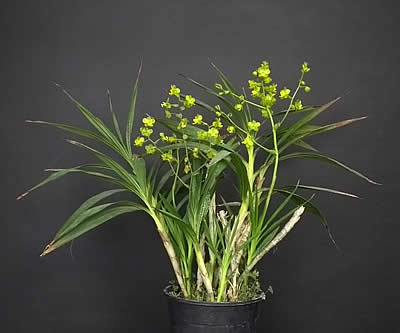The Yellow Cowhorn Orchid (Cyrtopodium flavum) is a natural, sympodial, terrestrial, and psammophyte (preferring sandy and dry locations) orchid. It is popularly known as Yellow Cowhorn Orchid and inhabits restinga areas from Rio Grande do Sul to Pará in Brazil. The genus name originates from the Greek Kyrtós (curved), combined with Pódion (diminutive of Podós = foot), meaning “little curved foot,” alluding to the curved upward base of the column. The species name derives from the Latin Flavus (yellow), reflecting the color of its flowers.
Its nomenclature is controversial; many botanists and orchid enthusiasts argue it should be named Cyrtopodium polyphyllum, as it was initially described by Velloso as Epidendrum polyphyllum in 1827. Therefore, when transferred to the genus Cyrtopodium, it should have retained this epithet. However, the Royal Horticultural Society (RHS) records Velloso’s nomenclature as dated 1831, a year after it was officially recognized. Further, many old-time orchid enthusiasts still refer to it as another synonym: Cyrtopodium paranaense. Here, we choose to follow the RHS.

The C. flavum features erect and cylindrical pseudobulbs, tapering gradually towards the top. Older pseudobulbs may shed their leaves. It flowers from spring to early summer, with floral stalks above the foliage, approximately 150 flowers each, 1 to 1.6 inches (2.5 to 4.0 cm) in diameter, fragrant, lasting about 30 days. This orchid does not reward its pollinators, instead mimicking the yellow flowers of nearby plants like Stigmaphyllon arenicola (oil) and Crotalaria vitellina (nectar).
It is found at elevations from sea level to 3,609 feet (1,100 meters). Favoring mild to warm climates, it thrives in sandy soils or on rocks. It should be grown in large plastic pots with substrate options such as a mixture of one part fertilized peat, two parts coarse washed sand, one part garden soil, and one part worm humus with a drainage base; or a substrate composed of three parts sand, one part charcoal, one part pine bark, and one part crushed stone. It can also be planted directly in the garden in beds prepared with good drainage using one of the aforementioned substrates.
The Yellow Cowhorn Orchid should be cultivated in full sun, with frequent watering in spring and summer, but avoiding waterlogging. In winter, C. flavum enters a dormant phase, reducing the need for watering. Care should be taken with new shoots, which are prone to rotting in excess moisture. Monthly fertilization can be done using organic fertilizer like AOSP or similar, applied over the substrate. A balanced, long-lasting NPK fertilizer such as cote is also recommended, following the manufacturer’s guidelines.
The ideal temperature range for its growth is wide, from 52 to 90°F (11 to 32°C). Although it is a full-sun plant, in orchidariums, it may be shaded up to 30%, with optimal light levels above 52,000 lux. It prefers relative humidity between 60 to 70%, alongside good ventilation. Propagation is through division of the clumps, ensuring each new section has at least four interconnected adult pseudobulbs and a well-rooted guide shoot.


